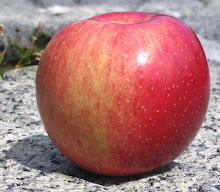A thoughtful reader asks whether the Baldwin Apple Monument I describe is the original.
A second monument to the Baldwin apple would be, in some ways, more astonishing than the first. I picture an Edward Gorey tableau: two knots of Victorian gentlemen in a field, glaring at each other.
That's fanciful of course, and I'm very interested to know the truth of it. The New York Times story I cite ("Monument to the Baldwin Apple," May 30 1895, p. 3) concludes
The granite shaft which is to be erected by the Rumford Historical Association of Woburn is seven feet high, and is surmounted by a representation of the Baldwin apple.
 That describes today's monument, and corroborates its inscription ("erected in
1895..."). It is one that gives no hint of having replaced any earlier
commemoration.
That describes today's monument, and corroborates its inscription ("erected in
1895..."). It is one that gives no hint of having replaced any earlier
commemoration.
The Boston Globe, which is the source of the Times article, notes there is
an additional inscription on the side of the monument, directing visitors to
the exact spot of the original tree, "250 feet west, 10º north" ("Far Famed
Baldwin Apple," May 1 1895, p. 9).
This inscription, with a helpful arrow, is on the northern face of the
monument and is today obscured by shrubs. Possibly the monument aligns to
that exact degree of orientation.
The main inscription, however, became controversial, and has been emended. According to the Globe, the inscription the monument bears today is wholly changed from the original, which read:
This pillar, erected in 1895 by the Rumsford Historical Association, incorporated April 27, 1877, marks the estate where in 1793 Samuel Thompson, Esq. while locating the line of the Middlesex Canal, discovered the first Pecker apple, later named the Baldwin.
This tells quite a different story than today, but is clearly chiseled on the monument's pillar in a photograph published in the Globe in 1908 ("Who Discovered the Baldwin Apple?" April 5 1908, p. 39).
In that year Colonel Baldwin's great grandson produced two letters that mentioned the apple (identifiably, though not by name) nine years before Mr. Thompson "discovered" it.
The level of interest in this controversy is a measure of the Baldwin's popularity at the time.
Mr. Johnson of the Historical Society responded by pointing his finger at an 1885 paper, "the best on the subject," by Rev. Leander Thompson, Samuel Thompson's great-grandson. The Globe says the question of Baldwin's origins had been studied by a special legislative committee in the 1850s.
Perhaps the image of the seething bands of well-dressed gentlemen is not so far-fetched.
The Boston Globe reported ("Inscription Is Inaccurate," March 29 1909, p. 16) it took the Rumsford Society a year to respond officially. A committee found,
these letters show that the Baldwin apple was known...at least as early as 1874, and are inconsistent with the statement on the monument.... It is no reflection on the public spirit of an honesty of purpose of our late associate Leonard Thompson, who so generously provided the funds to erect the monument, that certain facts which have only recently come to light are not in harmony with some of the statements included in the present inscription.
We fear, however, that any change in the inscription might be construed as criticism of Mr Thompson and his gift. For that reason...the committee hesitates to recommend any change at this time. If, however, any change is to be made, the following is suggested:
This pillar, erected in 1895 by the Rumsford Historical Association, marks the spot of the original Baldwin apple tree. The apple was early known as the Pecker apple, and the tree stood on the Butters estate until it fell in the gale of September 1815. There is documentary evidence that the apple was brought into prominence as early as 1784.
According to the Globe, the committee noted "that a bronze tablet containing the above can be inserted" covering the old inscription "at a cost of $100."
Fortunately those steps were not taken. Today's inscription is superior.

|
I do not know whether this answers the mystery of the "original" monument, but it is instructive how easily time can obscure the simplest events. Ironically we know more about the origins of the Baldwin today than did those living closer to the time.
Another lesson is that there is almost always more to the story than you think. But the most important takeaway is to take even "best on the subject" sources with a grain of salt. Along those lines, in 1906 the October 21 New York Times Magazine, in a story about "Apple Day" and the movement behind it, enthusiastically described the monument as
a granite shaft about twelve feet high surmounted by a heroic sample in stone of the celebrated apple.
Despite such exaggerations, the article is delightful for other reasons and is illustrated with a photograph showing the monument's original front and side inscriptions.

Comments
Post a Comment
Join the conversation! We'd love to know what you think.